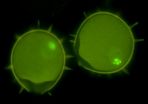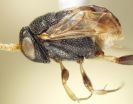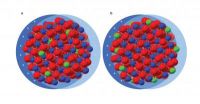(Press-News.org) With the bursting of spring, pollen is in the air. Most of the pollen that is likely tickling your nose and making your eyes water is being dispersed in a sexually immature state consisting of only two cells (a body cell and a reproductive cell) and is not yet fertile. While the majority of angiosperm species disperse their pollen in this early, bicellular, stage of sexual maturity, about 30% of flowering plants disperse their pollen in a more mature fertile stage, consisting of three cells (a body and two sperm cells). And then there are plants that do both.
So which is the ancestral state, why did the earlier onset of maturity (the tricellular state) evolve so often, and is the tricellular state an evolutionary "dead end"? These questions, and others, were tackled in the classic work by James L. Brewbaker in 1967 and have been revisited in a new study, drawing upon an impressive database of over 2000 species, to determine which came first, tri- or bicellular pollen, and which leads to greater species diversity.
In the 1920s it was proposed that tricellular pollen had evolved independently within angiosperms numerous times and was an irreversible state. These predictions were supported by a classic, elegant, and notable study conducted by Brewbaker and published in the American Journal of Botany in 1967. Brewbaker used data from 1,908 species in one of the first large-scale tests of an evolutionary developmental hypothesis. He mapped pollen state (bi- vs tri-) onto a phylogenetic tree and found that tricellular families always appeared to be nested within bicellular families. He thus concluded that bicellular pollen was ancestral and had given rise to tricellular pollen multiple times. He also concluded that tricellular pollen never seemed to give rise to bicellular pollen.
Joseph Williams, an associate professor at the University of Tennessee, has had a long-standing interest in the reproductive biology of flowering plants, and is particularly interested in the evolution of development of ancient flowering plants. As part of the Centennial Celebration of the American Journal of Botany, Williams and co-authors (University of Tennessee and Creighton University) decided to re-examine the core questions that Brewbaker tested using modern, updated phylogenies and many more species than Brewbaker had available to him 50 years ago (http://www.amjbot.org/content/101/4/559.full.pdf+html).
"I think many of us who did their graduate work during the '60s through the early '90s saw our first flowering plant phylogenetic tree when we opened the October 1967 issue of American Journal of Botany to Jim Brewbaker's two-page-wide tree comprising 265 families," comments Williams (http://www.jstor.org/stable/2440530?seq=4). "That he had only constructed the phylogeny to answer a question about the evolution of pollen development was even more impressive."
"Our Centennial Review paper moved from being a straightforward review to a research paper," explains Williams, "because new methods for studying evolutionary rates of binary traits had just come out, and I thought: Why not redo Brewbaker's analysis with modern methods? Coincidentally, we had been collecting data on pollen cell number for the last seven years, so we had a great dataset in hand. To his credit, Brewbaker had already anticipated all the important questions, so you could say that our paper just added clarity to the nearly 50-year-old answers he suggested."
Indeed, Williams and co-authors expanded the Brewbaker dataset by including 2,511 species for which they modeled trait evolution (tri- vs bicellular pollen) using a modern (2013) seed plant phylogeny and two different sets of analyses.
Much to their surprise, the results from their analyses did not strongly support a bicellular ancestry, contrary to Brewbaker's findings, and, in fact, were ambiguous as to the ancestral state. While one analysis pointed to a tricellular ancestry, another analysis—which allowed evolutionary rates of the traits to vary across a phylogeny—found more uncertainty at the base, with a tricellular ancestor only slightly more likely than a bicellular ancestor.
Interestingly, they also found that both bi- and tricellular lineages gave rise to each other. Thus, their analyses debunked the long-standing assumption that pollen states could only evolve in one direction, namely from bi- to tricellular, and that tricellularity was a "dead end."
"Furthermore, our study showed that despite the recurrent evolution of tricellular pollen, those lineages with tricellular pollen actually had slower evolutionary rates," adds Williams. "Tricellular lineages had both reduced net speciation rates (speciation minus extinction) and reduced rates of reverting to the bicellular state."
In other words, even though tricellular species are formed often, suggesting an advantage to this dispersal state, tricellular lineages evolve slowly. And the net effect is that bicellular species are more common than tricellular species.
The authors speculate further that ecology plays an important role in these findings.
"Tricellular pollen develops rapidly after pollination, and so it would be favored in many of the unique lifestyles of angiosperms that demand rapid reproduction, such as herbs, annuals, and herbaceous aquatics," Williams notes.
"But acquiring those kinds of habits has consequences. The pattern of tricellular lineages rarely re-evolving the bicellular state suggests a reduced ability to respond to changing pollen dispersal conditions over evolutionary time, which in turn has slowed their rate of diversification."
One of the ideas that Williams is interested in continuing to pursue is the conflict between the ecology of pollen dispersal (the free-living phase of pollen ontogeny) and the ecology of pollen tube growth after pollination (where pollen is protected and competes with other pollen for fertilization success).
"I'm currently working with large datasets that will allow me to look for correlations between dispersal traits—such as pollen dimensions, DNA content, cell number, pollen energy reserves, water content, pollination syndromes—and pollen tube performance traits—such as tube dimensions and elongation rates, style lengths and duration of growth," concludes Williams.
INFORMATION:
Joseph H. Williams, Mackenzie L. Taylor, and Brian C. O'Meara. Repeated evolution of tricellular (and bicellular) pollen. American Journal of Botany April 2014 101:559-571.
The full article in the link mentioned is Open Access at http://www.amjbot.org/content/101/4/559.full.pdf+html. Reporters may contact Richard Hund at ajb@botany.org for a copy of the article at any time.
The Botanical Society of America is a non-profit membership society with a mission to promote botany, the field of basic science dealing with the study and inquiry into the form, function, development, diversity, reproduction, evolution, and uses of plants and their interactions within the biosphere. It has published the American Journal of Botany for 100 years. In 2009, the Special Libraries Association named the American Journal of Botany one of the Top 10 Most Influential Journals of the Century in the field of Biology and Medicine.
For further information, please contact the AJB staff at ajb@botany.org.
Which came first, bi- or tricellular pollen? New research updates a classic debate
The rise and diversification of bi- and tricellular pollen in flowering plants
2014-05-02
ELSE PRESS RELEASES FROM THIS DATE:
Researchers find unique fore wing folding among Sub-Saharan African Ensign wasps
2014-05-02
Researchers discovered several possibly threatened new species of ensign wasps from Sub-Saharan Africa -- the first known insects to exhibit transverse folding of the fore wing. The scientists made this discovery, in part, using a technique they developed that provides broadly accessible anatomy descriptions.
"Ensign wasps are predators of cockroach eggs, and the transverse folding exhibited by these species may enable them to protect their wings while developing inside the cramped environment of cockroach egg cases," said Andy Deans, associate professor of entomology, ...
Probing dopant distribution
2014-05-02
The icing on the cake for semiconductor nanocrystals that provide a non-damped optoelectronic effect may exist as a layer of tin that segregates near the surface.
One method of altering the electrical properties of a semiconductor is by introducing impurities called dopants. A team led by Delia Milliron, a chemist at Berkeley Lab's Molecular Foundry, a U.S Department of Energy (DOE) national nanoscience center, has demonstrated that equally important as the amount of dopant is how the dopant is distributed on the surface and throughout the material. This opens the door ...
Drinking poses greater risk for advanced liver disease in HIV/hep C patients
2014-05-02
PHILADELPHIA—Consumption of alcohol has long been associated with an increased risk of advanced liver fibrosis, but a new study published online in Clinical Infectious Diseases from researchers at Penn Medicine and other institutions shows that association is drastically heightened in people co-infected with both HIV and chronic hepatitis C virus (HCV) infection. Even light ("nonhazardous") drinking—which typically poses a relatively low risk for uninfected persons—was linked to an increased risk of liver fibrosis in the co-infected group.
Reasons for this are not fully ...
Space Station research shows that hardy little space travelers could colonize Mars
2014-05-02
In the movies, humans often fear invaders from Mars. These days, scientists are more concerned about invaders to Mars, in the form of micro-organisms from Earth. Three recent scientific papers examined the risks of interplanetary exchange of organisms using research from the International Space Station. All three, Survival of Rock-Colonizing Organisms After 1.5 Years in Outer Space, Resistance of Bacterial Endospores to Outer Space for Planetary Protection Purposes and Survival of Bacillus pumilus Spores for a Prolonged Period of Time in Real Space Conditions, have appeared ...
Story tips from the Department of Energy's Oak Ridge National Laboratory, May 2014
2014-05-02
To arrange for an interview with a researcher, please contact the Communications staff member identified at the end of each tip. For more information on ORNL and its research and development activities, please refer to one of our media contacts. If you have a general media-related question or comment, you can send it to news@ornl.gov.
DIESELS – Reducing soot . . .
Nine U.S. diesel engine manufacturers and Oak Ridge National Laboratory are using their collective horsepower to tackle the perennial industry-wide problem of efficiency-robbing soot in engines. Over time, ...
Vanderbilt study explores genetics behind Alzheimer's resiliency
2014-05-02
Autopsies have revealed that some individuals develop the cellular changes indicative of Alzheimer's disease without ever showing clinical symptoms in their lifetime.
Vanderbilt University Medical Center memory researchers have discovered a potential genetic variant in these asymptomatic individuals that may make brains more resilient against Alzheimer's.
"Most Alzheimer's research is searching for genes that predict the disease, but we're taking a different approach. We're looking for genes that predict who among those with Alzheimer's pathology will actually show ...
Researchers find way to decrease chemoresistance in ovarian cancer
2014-05-02
ATLANTA--Inhibiting enzymes that cause changes in gene expression could decrease chemotherapy resistance in ovarian cancer patients, researchers at Georgia State University and the University of Georgia say.
Dr. Susanna Greer, associate professor of biology, and research partners at the University of Georgia have identified two enzymes that suppress proteins that are important for regulating cell survival and chemoresistance in ovarian cancer. Their findings are published in the journal, PLOS ONE.
Ovarian cancer is one of the deadliest gynecological cancers, with a ...
A transcription factor called SLUG helps determines type of breast cancer
2014-05-02
Findings and Significance: During breast-tissue development, a transcription factor called SLUG plays a role in regulating stem cell function and determines whether breast cells will mature into luminal or basal cells.
Studying factors, such as SLUG, that regulate stem-cell activity and breast-cell identity are important for understanding how breast tumors arise and develop into different subtypes. Ultimately, this knowledge may help the development of novel therapies targeted to specific breast-tumor subtypes.
Background: Stem cells are immature cells that can differentiate, ...
Key protein, FABP5, enhances memory and learning
2014-05-02
Case Western Reserve researchers have discovered that a protein previously implicated in disease plays such a positive role in learning and memory that it may someday contribute to cures of cognitive impairments. The findings regarding the potential virtues of fatty acid binding protein 5 (FABP5) — usually associated with cancer and psoriasis — appear in the May 2 edition of The Journal of Biological Chemistry.
"Overall, our data show that FABP5 enhances cognitive function and that FABP5 deficiency impairs learning and memory functions in the brain hippocampus region," ...
Better sleep predicts longer survival time for women with advanced breast cancer
2014-05-02
DARIEN, IL – A new study reports that sleep efficiency, a ratio of time asleep to time spent in bed, is predictive of survival time for women with advanced breast cancer.
Results show that higher sleep efficiency was significantly associated with lower mortality over the ensuing six years, an effect that remained after adjusting for baseline prognostic factors such as age, estrogen receptor status and treatments received. Mean survival was 68.9 months for efficient sleepers compared with 33.2 months for participants with poor sleep efficiency. Further analysis found that ...
LAST 30 PRESS RELEASES:
Making lighter work of calculating fluid and heat flow
Normalizing blood sugar can halve heart attack risk
Lowering blood sugar cuts heart attack risk in people with prediabetes
Study links genetic variants to risk of blinding eye disease in premature infants
Non-opioid ‘pain sponge’ therapy halts cartilage degeneration and relieves chronic pain
AI can pick up cultural values by mimicking how kids learn
China’s ecological redlines offer fast track to 30 x 30 global conservation goal
Invisible indoor threats: emerging household contaminants and their growing risks to human health
Adding antibody treatment to chemo boosts outcomes for children with rare cancer
Germline pathogenic variants among women without a history of breast cancer
Tanning beds triple melanoma risk, potentially causing broad DNA damage
Unique bond identified as key to viral infection speed
Indoor tanning makes youthful skin much older on a genetic level
Mouse model sheds new light on the causes and potential solutions to human GI problems linked to muscular dystrophy
The Journal of Nuclear Medicine ahead-of-print tip sheet: December 12, 2025
Smarter tools for peering into the microscopic world
Applications open for funding to conduct research in the Kinsey Institute archives
Global measure underestimates the severity of food insecurity
Child survivors of critical illness are missing out on timely follow up care
Risk-based vs annual breast cancer screening / the WISDOM randomized clinical trial
University of Toronto launches Electric Vehicle Innovation Ontario to accelerate advanced EV technologies and build Canada’s innovation advantage
Early relapse predicts poor outcomes in aggressive blood cancer
American College of Lifestyle Medicine applauds two CMS models aligned with lifestyle medicine practice and reimbursement
Clinical trial finds cannabis use not a barrier to quitting nicotine vaping
Supplemental nutrition assistance program policies and food insecurity
Switching immune cells to “night mode” could limit damage after a heart attack, study suggests
URI-based Global RIghts Project report spotlights continued troubling trends in worldwide inhumane treatment
Neutrophils are less aggressive at night, explaining why nighttime heart attacks cause less damage than daytime events
Menopausal hormone therapy may not pose breast cancer risk for women with BRCA mutations
Mobile health tool may improve quality of life for adolescent and young adult breast cancer survivors
[Press-News.org] Which came first, bi- or tricellular pollen? New research updates a classic debateThe rise and diversification of bi- and tricellular pollen in flowering plants




